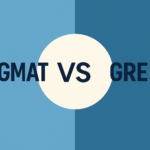The New GMAT Scoring System: What Is a Good Score in 2025?
!!!!!!!!!!!!700 IS NO LONGER THE NUMBER TO TARGET!!!!!!!!!!!!!

In 2023 there was a significant change to how the GMAT is scored, interpreted, and used by admissions committees worldwide.
After the scoring overhaul, myths and outdated score benchmarks continue to dominate test prep forums. (Of course if you’re reading the forums for anything except answer explanations, you’re already guaranteed a shitty score.)
One dumbshit thing that refuses to die is the obsession with a “700+” score, which, in the era of the Focus Edition, is not only misleading, it’s totally unreasonable. To wit: a 645-655 is a perfectly competitive score for Top 10 business schools. Not even the most demanding programs (read: Oxford’s Master in Finance) require a 700+ score on the GMAT anymore.
Clearly you don’t believe some asshole you’re reading on the internet, because the forums obviously have better information than this website. In that case, I suggest you leave this site now and go do the GRE (because you probably think it’s easier).
If, however, you want to understand how the GMAT is scored in 2025, read on.
Even GMAC Acknolwedges That the GMAT Scoring System Has Changed!
I mean hopefully, because they write the test…
Here’s their take:
645 is the New 700
On the GMAT Exam (10th Edition), many test takers aimed for a score of 700. On the GMAT Exam (Focus Edition), a score of 645 is equivalent to a 700 due to the new score scale. Therefore, while scores may look “lower” in comparison, they aren’t. The GMAT Exam (Focus Edition) is scored differently, and business schools know this when reviewing your application and paying more attention to your percentile ranking.
https://www.mba.com/exams/gmat-exam/scores/understanding-your-score
If you want to dig into more details about how the two versions of the test stack up, read on.
The GMAT Classic vs. the GMAT Focus Edition
Technically, the GMAT Focus Edition is now just the GMAT. The GMAT Classic (the old version) is not available to take any more. For the purpose of clarity, I will refer to these as GMAT Focus (the modern test) and GMAT Classic (the retired test).
Let’s start by laying out the key differences in format and scoring.
GMAT Classic (Pre-2023):
- Sections: Quantitative, Verbal, Integrated Reasoning, Analytical Writing Assessment (AWA)
- Score Range (Total): 200–800
- Sectional Scores: Quant and Verbal (6–51); IR (1–8); AWA (0–6)
- Time: About 3 hours 30 minutes
GMAT Focus Edition:
- Sections: Quantitative, Verbal, Data Insights (no AWA)
- Score Range (Total): 205–805
- Sectional Scores: Each section scored 60–90
- Time: About 2 hours 15 minutes
- Adaptive Structure: Section-level adaptive with question review and editing allowed
Most importantly, the score scale has changed, and the percentile distributions have shifted. The new scoring system is not directly comparable to the old one.
What Is a Good GMAT Focus Score?
This is the most common question test-takers have. Under the old GMAT scoring system, 700+ was widely seen as a benchmark of excellence, putting students roughly in the 88th-90th percentile.
With the GMAT Focus, a good score is approximately 655 or higher, which places a test-taker in a similar percentile band as the old 700. Here’s a quick breakdown:
| GMAT Focus Score | Percentile (2024 Data) |
| 805 | 100th %ile |
| 765 | ~99.9th %ile |
| 725 | ~99.2nd %ile |
| 685 | ~96.2nd %ile |
| 655 | ~91.3rd %ile |
| 625 | ~80.5th %ile |
| 595 | ~68.5th %ile |
So what’s a good score? Here are a few ballpark figures:
- More than you fucking need, but hey it’s worth a shot: 685–805
- Competitive for Top 10 MBAs: 645-655+
- Good for Top 25 MBAs: 605–655
- Average Performance: ca. 555
Remember, the average GMAT Focus score is 553.5 according to GMAC (data from 2019-2024).
How to Compare GMAT Focus Scores to Old GMAT Scores
While GMAC insists that GMAT Focus scores are not directly convertible to old scores, they have released score concordance tables to help schools and students make approximate comparisons.
Here is a rough equivalency table:
| Old GMAT Score | GMAT Focus Score |
| 760 | 715–735 |
| 740 | 685–695 |
| 720 | 665-675 |
| 700 | 645–655 |
| 680 | 615-635 |
| 660 | ca. 615 |
Key takeaway: A 645-655 on the GMAT Focus corresponds approximately to a 700 on the old GMAT scoring system in terms of percentile rank.
So if you hear someone say, “You need a 700,” the correct modern equivalent is a 645.
If anyone insists that it still needs to be a 700, then that person is full of shit, trolling you, or simply an idiot. Not that these are mutually exclusive categories; judge for yourself.
If It is not clear by now, allow me to provide an example: a 705 on the GMAT Focus is a higher score than even the most demanding programs (e.g. Oxford’s Master in Finance) would require.
NO SCHOOL CURRENTLY REQUIRES A 700+ ON THE GMAT. STOP TELLING ME YOU NEED A 700.
IT’S GETTING TIRESOME.
What Scores Do Top MBA Programs Want in the Focus Edition Era?
Let’s look at what some of the top 10 MBA programs have published or implied in the past year:
Harvard Business School
- Previously: GMAT average ~730 (old scale)
- Now: Focus scores in the 675–715+ range are expected
Stanford GSB
- Previously: GMAT average ~738 (old scale)
- Now: Focus scores ~685–715 are competitive
Wharton
- Previously: GMAT average 732
- Target range: 675–725+
Booth, Kellogg, MIT Sloan, Columbia, Haas, Yale SOM
- Previously: 710-730
- Range: 655–705+
While schools are adjusting to the new scale, the percentile remains the guiding metric. A 90th percentile GMAT Focus score (around 655) is what most top schools now expect from competitive applicants.
Some programs now publish both old and new scores in their class profiles, but within a year or two, the only applicant scores will be GMAT Focus scores so this will be the new standard.
Why People Still Obsess Over “700”
Despite the rollout of the new system, the number “700” still looms large in MBA folklore. Here’s why:
1. Historical Prestige
- For over many decades, a 700+ score has been shorthand for excellence.
- It symbolized elite-level ability and separated top applicants.
2. Forums and Outdated Advice
- MBA forums, Reddit threads, and older blog posts continue to reference 700 because they haven’t updated their frameworks. Oh yeah–they’re also full of dipshits.
- Peer pressure from outdated benchmarks leads test-takers astray.
3. Mental Anchoring
- 700 is a round, memorable number. Many test-takers psychologically anchor to it.
- Even though 645 is the new benchmark, 700 feels more “real” because it’s been used for so long.
4. Reporting Lag
- Some schools still show old scores or don’t clarify the distinction, reinforcing the myth.
5. Test Prep Industry Marketing
- Many prep courses still advertise “How to score 700+” because it has brand value.
- Updating to “645+” doesn’t carry the same mystique—even though it’s more accurate.
6. Schools Not Understanding a Damn Thing
GMAC has made herculean efforts to educate adcoms about the changes, but a lot of the marketing and face-to-face admissions officers don’t understand what they’re talking about.
Unfortunately this doesn’t necessarily reach the lower echelons of people involved in admissions at these schools. Some of the admissions officers you see at fairs, etc. are strictly front-of-house (for various reasons, none of which are probably flattering) and a shocking number of these folks are totally unaware of the changes to the exam and/or grossly misinformed about said changes.
If one of these people tells you you need a 700, that’s probably not a school you want to go to because they employ idiots. Just imagine what that says about the education the school offers…
What Should You Aim for Now?
Let’s be realistic. Your target depends on your profile, school goals, and context.
Tiered Targets Based on MBA Tier:
- Top 5 MBAs (Harvard, Stanford, Wharton): 675–725+ (GMAT Focus)
- Top 10 MBAs: 645–705+
- Top 25 MBAs: 615–655
- Other strong programs: 595–625 acceptable with a strong application
If you’re scoring below 625, your score will need to be offset by exceptional professional experience, leadership, GPA, or diversity factors.
Should You Retake the GMAT Focus to Improve Your Score?
A retake makes sense if:
- Your current score is below the 80th percentile for your target school
- You were scoring 20+ points higher in practice
- You have time to improve your weakest section
Because the Focus Edition is shorter and more targeted, many students find it easier to retake than the old GMAT. Additionally, schools do not penalize multiple attempts, and some even superscore.
Tips to Improve Under the New Scoring System
- Master Data Insights:
- This section is new but crucial. Excel-like logic and multi-source reasoning matter.
- This section is new but crucial. Excel-like logic and multi-source reasoning matter.
- Balance Verbal and Quant:
- Each section has equal weight in the total score.
- Each section has equal weight in the total score.
- Use the Question Review Feature Wisely:
- You can now mark questions and return later—a strategic advantage.
- You can now mark questions and return later—a strategic advantage.
- Understand Score Weighting:
- Each section contributes equally (1/3) to your total score.
- Each section contributes equally (1/3) to your total score.
- Focus on Percentiles, Not Raw Scores:
- Always compare yourself to the current percentile, not old numbers.
- Always compare yourself to the current percentile, not old numbers.
Final Thoughts: Your GMAT Focus Score Strategy
The GMAT Focus Edition has recalibrated how we think about scores. A 700 is no longer the gold standard—a 645 on the new scale is its modern equivalent.
By clinging to outdated benchmarks, test-takers may set unrealistic or irrelevant goals. Instead, focus on your percentile, target balance across sections, and align your score with your broader application strategy.
Smart applicants today don’t ask, “Did I get a 700?”
They ask: “Am I in the 90th percentile or above?”
Because that’s what schools care about. That’s what success looks like in the GMAT Focus era. This is not least because the test was recalibrated to make the percentile rankings, well, actually give an accurate read on one’s management ability and critical thinking skills.
After all, that is the point of the GMAT.
Key Takeaways
- The GMAT Focus Edition score range is 205–805.
- A 645 is roughly equal to a 700 on the old GMAT.
- Top 10 MBA programs now look for scores around 645–725.
- 700 is an outdated benchmark rooted in the old scoring system. STOP USING IT.
- Focus on percentiles, not legacy scores.





